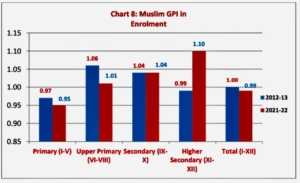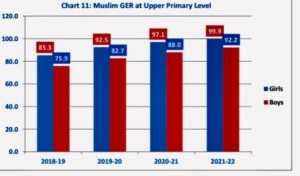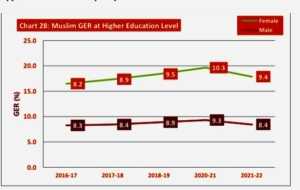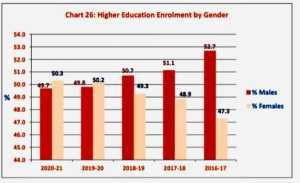Muslims Gross Enrolment Ratio at Higher Education Level (2020-21)
A detailed analysis based on AISHE 2020-21 Gross Enrolment Ratio 2020-21 is presented both at the state and all-India level which is based on projected population estimated based on 2011 Census.
Table 35 sheds light on the enrolment of Muslim students in higher education and reveals some significant trends and challenges. While the number of Muslim students enrolled in higher education is increasing, there is still a considerable gap between eligible Muslim students aged 18-23 and the actual enrolment figures, which suggests that barriers hinder Muslim students’ access to higher education.
Table 34
Share of Muslim Enrolment at School to Total Muslim Enrolment
at Higher Education Level
|
Year
|
% Muslim Enrolment at School Education Level (Grades 1 to 12) to Total (Muslim) Higher Education Enrolment |
||
| Male | Female | Both | |
| 2020-21 | 5.26 | 5.35 | 5.31 |
| 2019-20 | 5.98 | 6.02 | 6.00 |
| 2018-19 | 6.10 | 5.92 | 6.01 |
| 2017-18 | 5.67 | 5.42 | 5.55 |
| 2016-17 | 5.52 | 4.93 | 5.22 |
Source: Calculated based on AIHES 2020-21.
The Gross Enrolment Ratio (GER) of Muslims in higher education has shown improvement over the past few years, with a rise from 8.24 percent in 2016-17 to 8.91 percent in 2020-21. Although the highest GER of 9.79 percent was recorded in 2019-20, there was a decline in the following year. Despite this progress, the GER of Muslim students remains significantly lower than the national average of 27.3 percent, indicating that various challenges still deter Muslim students from enrolling in higher education.
The barriers preventing Muslim students from pursuing higher education could include financial constraints, limited access to quality education, and societal and cultural factors. To address these challenges and to create a more equitable society, specific steps as specified below may be initiated:
- Provide Financial Assistance: Offering financial support to economically disadvantaged Muslim students would help alleviate the financial burden associated with higher education. Scholarships, grants, and educational loans tailored to the needs of Muslim students can encourage them to pursue higher studies.
- Increase Scholarships & Grants: Increasing the number of scholarships and grants explicitly targeting Muslim students would incentivize and enable them to access higher education. These financial aids can make a significant difference in encouraging enrolment.
- Improve Access to Quality Education: Ensuring Muslim students in rural and underserved areas have access to quality education is vital. Establishing more schools and educational facilities in these regions and improving their infrastructure and teaching standards can enhance the likelihood of students progressing to higher education.
By taking these steps and addressing the barriers that hinder Muslim students’ enrolment in higher education, India can work towards building a more inclusive and equitable education system, which shall benefit Muslim students and contribute to the nation’s overall socio-economic development, fostering a diverse and empowered generation of individuals capable of achieving their full potential, regardless of their religious background.
Table 35: Muslim Gross Enrolment Ratio at Higher Education Level
| Gender |
Muslim Enrolment in Higher Education |
|||||
| 2016-17 | 2017-18 | 2018-19 | 2019-20 | 2020-21 | ||
| Both | 1739218 | 1837609 | 1959004 | 2100860 | 1921713 | |
| Male | 916388 | 939488 | 993396 | 1046374 | 954655 | |
| Female | 822830 | 898121 | 965608 | 1054486 | 967058 | |
| Muslim Projected Population (Age Group 18-23) | ||||||
| Both | 21102505 | 21219036 | 21335568 | 21452099 | 21568630 | |
| Male | 11095360 | 11149017 | 11202673 | 11256330 | 11309987 | |
| Female | 10007145 | 10070020 | 10132894 | 10195769 | 10258643 | |
| Gender | Muslims Gross Enrolment Ratio (%) | |||||
| Both | 8.24 | 8.66 | 9.18 | 9.79 | 8.91 | |
| Male | 8.26 | 8.43 | 8.87 | 9.30 | 8.44 | |
| Female | 8.22 | 8.92 | 9.53 | 10.34 | 9.43 | |
| The projected population of Muslims in different age groups has been obtained based on Expert Committee Projections (Total) by assuming that the 2011 Census share of 14.23 percent of the Muslim to Total population is still valid in 2021. | ||||||
State-specific Muslim GER at the Higher Education Level
The analysis of the Muslim Gross Enrolment Ratio (GER) in Higher Education across various states of India reveals significant variations in educational opportunities for Muslim students (Table 36). The GER is a crucial indicator of the educational attainment of Muslim communities in each state. It sheds light on the progress and challenges in providing equitable access to higher education.
Kerala and Lakshadweep stand out with higher Muslim GERs, indicating a more robust enrollment rate of Muslim students in higher education than the national average. These states are known for their emphasis on education and relatively higher literacy rates, which likely contribute to the higher GER. On the other hand, states like Assam and Bihar report lower Muslim GERs, indicating barriers and challenges in ensuring equal access to higher education for Muslim students. Socio-economic disparities, lack of educational resources, and social and cultural factors may hinder Muslim students’ enrollment and educational choices in these states.
Let us further explore the analysis of a few states:
- Andhra Pradesh: The state has a Muslim population share of 9.56 percent of the 2011 population. The Muslim GER for the 18-23 age group is 10.12 percent for both genders, with a slightly higher GER for males (10.75 percent) than females (9.44 percent). While the GER is higher than the national average, efforts should be directed toward further improving enrollment rates and addressing any barriers that may hinder equal access to higher education for Muslim students.
- Assam: With a significant Muslim population share of 34.22 percent of the total 2011 population, Assam faces challenges in providing equitable access to higher education. The Muslim GER within the 18-23 age group stands at approximately 6.5 percent for all genders, indicating a need for targeted measures to enhance enrollment rates and remove barriers hindering educational opportunities for Muslim students.
- Bihar: Bihar, with a substantial Muslim population share of 16.87 percent of the total 2011 population, reports a Muslim GER of around 6 percent for both genders within the 18-23 age group. Efforts should focus on improving enrollment rates and addressing socio-economic factors that may impede access to higher education for Muslim students.
- Kerala: Kerala boasts a significant Muslim population share of 26.56 percent of the total 2011 population. Within the 18-23 age group, the Muslim GER is remarkably high, at 20.35 percent for both genders, which indicates a strong enrollment rate among Muslim students in higher education. Notably, the female GER surpasses the male GER, showcasing Kerala’s commendable efforts in promoting gender inclusivity in education.
- Jammu & Kashmir: Jammu & Kashmir has a substantial Muslim population share, making up 68.31 percent of the total 2011 population. Within the 18-23 age group, the Muslim GER in the state is 12.06 percent for both genders. While this GER is relatively higher than in some other states, there is room for improvement to ensure more equitable access to higher education for Muslim youth. Initiatives should focus on expanding educational infrastructure, addressing socio-economic factors that may hinder educational opportunities, and fostering an inclusive environment encouraging higher education enrollment among Muslim students in Jammu & Kashmir.
- Lakshadweep: Lakshadweep stands out with a predominantly Muslim population, comprising 96.58 percent of the total population. Within the 18-23 age group, the Muslim GER is 4.32 percent for both genders. While the GER is lower than the national average, efforts can be directed toward increasing access to higher education and ensuring that Muslim youth in Lakshadweep have equal opportunities to pursue higher studies. Initiatives to enhance educational infrastructure, provide more resources, and address socio-economic barriers can help improve educational access for Muslim students in Lakshadweep.
- Rajasthan: Rajasthan has a Muslim population share of 9.07 percent of the total 2011 population. Within the 18-23 age group, the Muslim GER in the state stands at approximately 5 percent for all genders. While the GER is relatively moderate, there is scope for improvement to enhance access to higher education for Muslim students in Rajasthan. Addressing socio-economic disparities, promoting educational awareness, and providing support systems can contribute to bridging the gap and improving enrollment rates among Muslim students in the state.
- Uttar Pradesh: Uttar Pradesh, with a significant Muslim population share of 19.26 percent of the total 2011 population, reports a Muslim GER of approximately 5 percent within the 18-23 age group. The state faces challenges in providing equitable access to higher education for Muslim youth. Efforts should improve infrastructure, promote educational awareness, and address socio-economic factors to enhance enrollment rates and ensure equal opportunities for Muslim students to pursue higher education.
- West Bengal: West Bengal, with a notable Muslim population share of 27.01 percent of the total 2011 population, exhibits a Muslim GER of approximately 8.5 percent within the 18-23 age group. While the GER in West Bengal is higher than the national average, there is scope for further improvement. Continued efforts to enhance access to higher education, address socio-economic disparities, and foster an inclusive educational environment will contribute to the overall development of Muslim students in West Bengal.
Table 36: State-specific
Muslim Gross Enrolment Ratio at Higher Education, 2020-21
|
State/UT |
%age Share of Muslim to Total 2011 Population |
Muslim GER |
||
| Both | Male | Female | ||
| A & N Islands | 8.517 | 14.71 | 11.69 | 17.98 |
| Andhra Pradesh | 9.556 | 10.12 | 10.75 | 9.44 |
| Arunachal Pradesh | 1.955 | 2.69 | 2.99 | 2.37 |
| Assam | 34.223 | 6.46 | 6.42 | 6.51 |
| Bihar | 16.866 | 6.13 | 5.9 | 6.39 |
| Chandigarh | 4.874 | 8.63 | 7.08 | 10.67 |
| Chhattisgarh | 2.016 | 7 | 5.95 | 8.07 |
| Delhi | 12.859 | 7.09 | 7.65 | 6.49 |
| Goa | 8.335 | 19.49 | 17.29 | 22.03 |
| Gujarat | 9.674 | 4.59 | 4.72 | 4.45 |
| Haryana | 7.027 | 4.49 | 5.9 | 2.83 |
| Himachal Pradesh | 2.183 | 7.2 | 7.1 | 7.33 |
| Jammu & Kashmir | 68.314 | 12.06 | 11.36 | 12.84 |
| Jharkhand | 14.532 | 5.11 | 4.94 | 5.29 |
| Karnataka | 12.919 | 15.78 | 15.97 | 15.57 |
| Kerala | 26.562 | 20.35 | 15.8 | 25.16 |
| Lakshadweep | 96.58 | 4.32 | 1.78 | 7.08 |
| Madhya Pradesh | 6.574 | 6.57 | 6.35 | 6.8 |
| Maharashtra | 11.543 | 10.04 | 9.97 | 10.11 |
| Manipur | 8.398 | 14.38 | 12.15 | 16.69 |
| Meghalaya | 4.395 | 12.39 | 13.71 | 11.04 |
| Mizoram | 1.352 | 4 | 5.04 | 2.92 |
| Nagaland | 2.475 | 3.82 | 3.22 | 4.46 |
| Odisha | 2.172 | 8.05 | 8.83 | 7.24 |
| Puducherry | 6.054 | 25.74 | 27.73 | 23.93 |
| Punjab | 1.93 | 26.92 | 35.01 | 17.02 |
| Rajasthan | 9.067 | 5.08 | 5.48 | 4.64 |
| Sikkim | 1.616 | 10.44 | 13.7 | 6.78 |
| Tamil Nadu | 5.862 | 27.59 | 30.34 | 24.68 |
| Telangana | 9.556* | 33.55 | 33.27 | 33.84 |
| D & N & D & D | 5.49 | 4.36 | 3.27 | 6.65 |
| Tripura | 8.602 | 3.24 | 3.14 | 3.34 |
| Uttar Pradesh | 19.26 | 5.43 | 4.7 | 6.26 |
| Uttarakhand | 13.948 | 12.48 | 11.16 | 13.94 |
| West Bengal | 27.011 | 8.46 | 7.67 | 9.3 |
| All India (Muslims), 2021-22 | 14.225 | 8.91 | 8.44 | 9.43 |
| All India (All Communities), 2020-21 | 26.7 | 27.9 | 27.3 | |
|
Source: Calculated based on the Projected Muslim Population of the 18 to 23 age group and enrolment provided through AIHES 2020-21. Based on the total population of the Age Group 18-23 years, a state-specific share of Muslims to the total population in 2001 is applied to obtain the Muslim population (18 to 23 years), which is then applied to get Muslim GER. * Of undivided Andhra Pradesh. |
||||
The analysis of state-wise Muslim Gross Enrolment Ratio (GER) in Higher Education within the 18-23 age group indeed provides valuable insights into the educational opportunities available to Muslim youth in different states of India. It is essential to recognize that achieving a GER of 100% in higher education is not a practical expectation, as it requires a continuous educational journey from primary to higher education levels. Instead, the GER should be understood as a measure of progress in providing access to higher education for eligible students within the 18-23 age group.
Comparing the GER of different states with their percentage share in the total population may not accurately reflect the educational opportunities available to Muslim students. A more appropriate comparison involves examining the share of Muslim enrolment to the total enrolment in higher education within each state. This comparison highlights the representation and access of Muslim students in higher education, regardless of the state’s overall population share.
States like Kerala and Jammu & Kashmir stand out with commendable GERs, indicating relatively higher enrollment rates of Muslim students in higher education. These states serve as examples of efforts to promote inclusivity and equitable access to education for all students, including Muslims.
On the other hand, states such as Lakshadweep, Rajasthan, Uttar Pradesh, and West Bengal face challenges in providing access to higher education for Muslim students. To address these challenges and ensure equal educational opportunities, policymakers and stakeholders should prioritize initiatives that address barriers to enrollment, promote gender inclusivity in education, and bridge socio-economic disparities.
Creating an inclusive and equitable education system is vital for empowering Muslim students and fostering their holistic development. By providing equal educational opportunities and support to all students, regardless of their backgrounds, India can work towards building a more inclusive and prosperous society where every individual has the chance to reach their full potential and contribute to the nation’s progress and development.








